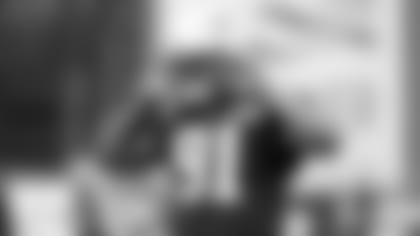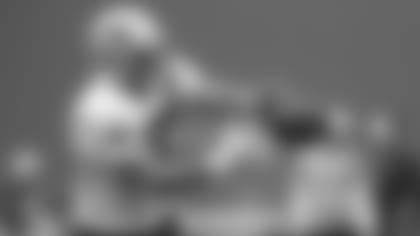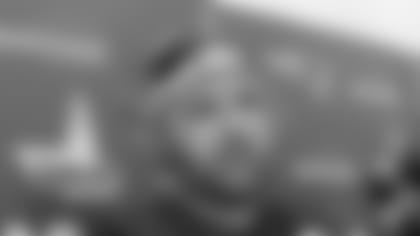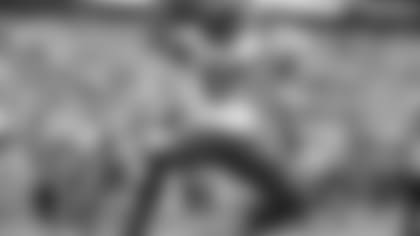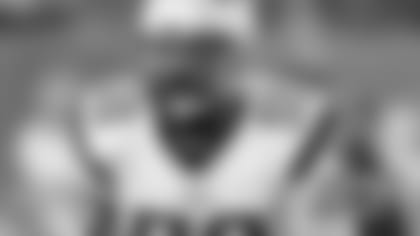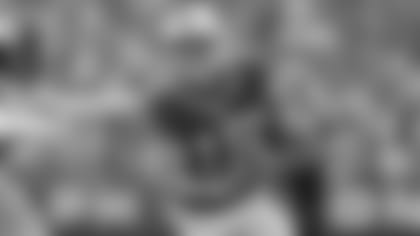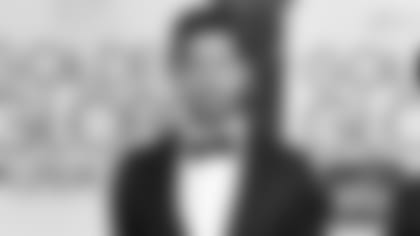Patriots head coach Bill Belichick addresses the media during his press conference at Gillette Stadium on Sunday, April 26, 2009.
BB:We had an interesting day today. Things turned out at the end a little different from the way they looked like they were going to start. I'll just kind of recap things for you from the way they unfolded this morning. We came in and had the four picks in the third round and Jacksonville pretty quickly came after that first third round pick and we pushed that into a second round pick in next year's draft. And then we selected Brandon Tate. He's a very versatile player, an explosive returner. He was a very productive player at North Carolina the last couple of years. I think a combination of factors, certainly the injury and other factors, probably led to him being available at that point in the draft and we felt like that was a good value at that point. And then Tennessee was involved in that third pick and we pushed that to the 2010 draft as well in the second round. And then in the compensatory pick we took Tyrone McKenzie. He's an interesting player that we caught up with at the Senior Bowl. He started off at Michigan State, was a productive player there. He had some family situations so he had to leave Michigan state [and] go to Iowa State. Started in that program -- same thing at Iowa State. Went to South Florida, walked on at South Florida, and again jumped in and was an immediate impact player on that program as well. I think his versatility and being involved in some different defensive systems, how quickly he was able to adapt and be productive and show his flexibility and versatility in those things was pretty impressive at a very high level and really almost immediately he was a positive impact in those programs. So it kind of felt like we were going to have a little lull in the action there and kind of get caught up and get reorganized a little bit and [we] ended up making a trade with Philadelphia for the two fifth round picks at the top of the fifth round. We traded Ellis [Hobbs] there. I'll just say that the Ellis Hobbs trade was not really something that we anticipated. It was just one of those things that, based on the way things went and where are team was and what the opportunity was with Philadelphia and so forth, we felt that that was the best thing to do for our team. So we made that transaction, and then moved back up into the fourth round to take Rich Ohrnberger. Rich is a strong, physical inside player at Penn State. He's played primarily guard, but has also worked at center. I think he has some versatility in there. [We] also moved into the sixth round as part of that trade and ended up picking up Jake Ingram, a long snapper from Hawaii. And then we added a couple more big guys along the way with [Myron] Pryor and [Darryl] Richard and [George] Bussey. So we ended up with three offensive lineman, three defensive lineman [in this draft] and I just don't think you can ever enough of those guys. That's not any kind of commentary on anybody who's here or isn't here, it's just we had picks, they were available and they're not usually there and we took them. I think it's a little bit unusual that we ended up with all three [offensive] linemen who were non combine guys and the fact that they weren't at the combine and kind of the way that we evaluated them in their private workouts and so forth, I think all of them are pretty impressive, all different. [Sebastian] Vollmer is a big right tackle, a big good-looking right tackle type of guy. Ohrnberger is more of an inside player, center/guard type. Bussey played right tackle at Louisville on the same line as [Eric] Wood and was a very effective player there. And [Julian] Edelman, of course, is another non combine guy who played quarterback at Kent State. A very good runner. We see him as a player who has some versatility, probably as a receiver, maybe a running back. We'll see how that goes. He also played in the kicking game, so we kind of took him as an athlete and we'll just see how all that works out. That's kind of where we are here at the end of the day today. A big day of team building. We're looking forward to bringing everybody in this weekend and seeing how that crop looks. Sorry for the long-winded recap, but I think that's most of it.
Q:Moving Ellis [Hobbs], would you clarify that as a chance to clear salary cap space or giving [Terrence] Wheatley and [Jonathan] Wilhite a chance?
BB: I think there are a lot of forces at work there. I would just say that it's a combination of a lot of things that we felt like, from a timing standpoint and moving forward, 'what's the best thing for our football team?' That was just the right move at this time. Philadelphia was a partner on that and it just felt like when we talked to them that that was the best thing for our football team. It wasn't any one thing. It wasn't any one force, but it was just kind of a combination of all of those things coming together.
Q:How was the draft evaluation process different with a guy like Brandon Tate?
BB: The only thing you had to go on with Tate was the first half of the season. There was no spring workout and all of that. The ability to do the testing and all of that wasn't there so you had to go on what you saw in film. With that type of thing, our medical people evaluated the situation and gave us an opinion on where that stands. So we'll just see him this weekend and let him continue on his rehab and just kind of see how that time frame goes. I can't tell you exactly what that's going to be, but we'll know a lot more when we start working with him. Obviously, we think that in time he'll be able to get back to where most players are when they have that type of injury.
Q:Was there any disappointment at not landing an outside linebacker?
BB: As always, there's a lot of players on the board that we like and we drafted the ones that we felt gave us the best value at that particular time. There were a lot of players on the board that are good football players that we could have had and for some reason or another it just didn't work out this time at every position.
Q:Did you agree with [NFL Network Analyst Mike] Mayock that there was a lot of outside linebacker depth?
BB: I'm not really sure. That's a good question. I think that the outside linebacker group was a little bit different this year. I mean, generally speaking, I think that there were more shorter players, maybe a little less speed than what we've seen, maybe a little more power with good production. There weren't a lot of 4.6, 4.65 [40 time] guys. There weren't a lot of 6-[foot]-4, 6-[foot]-5 guys. I'd say it was a much smaller pool of those types of players.
Q:Following up on that, you've talked about [first year to second year] being a big jump for any rookie. For a guy like Shawn Crable, is he here in the program? And how do you evaluate him now in the one to two-year jump when he hasn't been on the field much?
BB:I think that the player at this point in time can do things to prepare [himself] for when he does go out on the field, and that's physically, film study, meeting with the coaches, having a better understanding of the system. Certainly a rookie player, whether they played or not, that's been in our program for a year knows a lot more and is a lot better prepared for all the things that he'll be doing both on and off the field, in the classroom, in practices and all that than he was a year ago when he walked in cold. I think the whole mental and physical process is really accelerated in the second year relative to the first year because they know a lot more about what to expect, what they need to work on, what their weaknesses are, where they're deficient, where they need help: coaches, technique, training, whatever it happens to be. I think any player that is open to that, works hard at it and tries to address it will make significant improvements. Hopefully, that's what they've all done and we will see that when we get back on the field. We won't be able to measure that until we get out there. I think you can gain a lot of ground between the end of the season, at whatever point those players played to last season, to where they will be at the start of this year.
Q:Without having practiced them, do you have a feel for the three defensive linemen? Do they have position flexibility? Are they inside guys?
BB:Well, I think they are all big – 300 pounds plus. I think [Darryl] Richard and [Myron] Pryor are quick guys that run pretty well for their size. [Ron] Brace is a bigger player, very powerful and explosive, [with a] different playing style. [He's] a little bit taller so I think there is some degree of flexibility between playing on the center, playing on the guard, and playing between the tackle and the guard, or on the tackle in varying degrees with all three players. How that actually manifests itself, we'll see. But I think there is some degree of versatility with all those players in doing that as there is with some of the other players we have on our roster. Vince [Redd] played end as a rookie. Mike Wright's played inside and has played outside. Jarvis [Green] and Richard [Seymour] have played outside and moved inside in some sub situations. Ty [Warren] has also done that [and] actually played nose [tackle] his rookie year. I don't think that's uncommon. We've had players like Ted Washington who were exclusively interior players and then some other guys that were exclusively on the perimeter. Le Kevin [Smith] has played inside and outside. I think there is an element of that to all these players and we'll see how that works out when we get them out there. I think the big thing about all these guys are the techniques they used in college and the way they actually played is probably going to be a little different here than what they did in college. It's going to be a learning curve. There is going to be some teaching, but from a physical standpoint and a talent standpoint they have the ability to do that, and they'll have to adapt to the techniques we use.
Q:[On Tyrone McKenzie] It's usually a negative to have gone to two or three different schools over the course of your career but obviously there were some factors. Speaking with him today he sounded like a very mature guy and appreciative for all he's been through. Can you talk a little bit about what he's had to overcome to get here?
BB:I think Tyrone can speak more on that directly, but I would just say of all the players that I've talked to and we've interviewed this year and even through the years, that Tyrone is amongst the most impressive. Maturity, intelligence, what he's done with the opportunities that he's had or that he's had to overcome, how he's approached them, how he's dealt with them, how he's made the most of them. It hasn't been easy. Yet, he's continued to excel, jump over hurdles and overcome obstacles that I think would have derailed a lot of other people and/or football players. I think he's a very impressive, mature, humble young man.
Q:You don't normally see a long snapper drafted. What was it about Jake Ingram that you really liked?
BB:We thought that Ingram would be in competition for the position with Nathan [Hodel]. He's an athletic guy, a little bit smaller than some of the snappers in the league, but a little bit more athletic than most of the snappers in the league. I think his athleticism versus his size is kind of the comparison or where the competition will be. [He's] an experienced guy. He's done that. He can block. He can cover pretty well. His snaps are accurate; they had good velocity. So I think that he will be competitive for that position. I felt like he was a top player for his position in the draft.
Q:You mentioned some concerns about Brandon Tate and his health issues. One was a positive drug test at the combine. To what degree were you concerned about that?
BB:As we talked about last week, those are things that I can't talk about. They're confidential and I really can't address those. Again, I would say in the big picture, every player has things positives and negatives in their entire profile, whatever that happens to be. In the end, you just have to evaluate that player, your team and your situation and what kind of value you put on that and what kind of fit you think it will be. I'm glad we have Brandon. He brings a lot to our football team and he'll hopefully work hard to do the things he needs to do to be a productive player for the Patriots. That's what my expectations are. We're comfortable taking him at the point [and] in the situation that we took him in and I think he has a good future here.
Q:Where do you see his progress with the injury?
BB:I think we'll know more about that when he comes in here this weekend. But he's rehabilitating it and I expect him to work hard to try to get back on the field as quickly as possible, whenever that is. So that's a medical decision.
Q:In a general sense, do you usually have the same feelings after every draft? Do you feel some years you are able to accomplish more than others and where might this year's two days fit?
BB:I think at each point where you have a decision to make you try to maximize it and that's what we tried to do in each one. At some point in time, we'll be able to look back and have a better gauge of how all that came down. We'll actually see everybody perform and how it turns out. At the time, you try to make the best decisions for your football team given whatever the parameters are and that's what we tried to do today. I would say again that Nick Caserio, Jon Robinson, the entire scouting staff and personnel department did an outstanding job of organization, communication, providing information and a lot of details, and we tried to use that information collectively as an organization to put ourselves in the best position to help our team. I'm not saying all those decisions were perfect or right. We'll find out about those in time, but that's what we tried to do. At the same time, 12 draft picks this year and I think a good group of players to work with [and] we're in fairly good position next year to be competitive in the next drafting cycle. I felt like we tried to use our picks productively, but — at the same time — look forward into the future and position ourselves to be in a good competitive situation in 2010. Hopefully, we will still be in business then. The draft's a short-term project, but it's a long-term project. It's into the future, too. That's the grassroots of your team is players that you draft this year, next year and in future years. All of that is important.






















